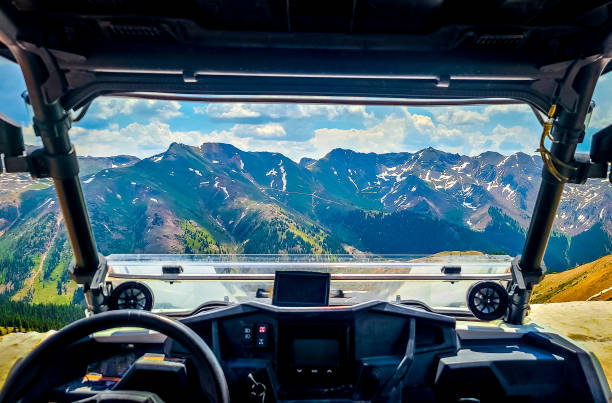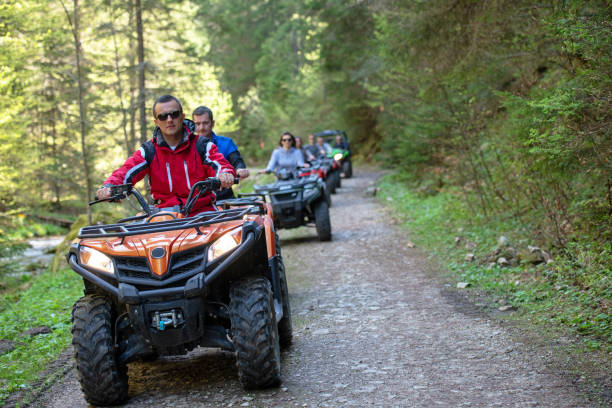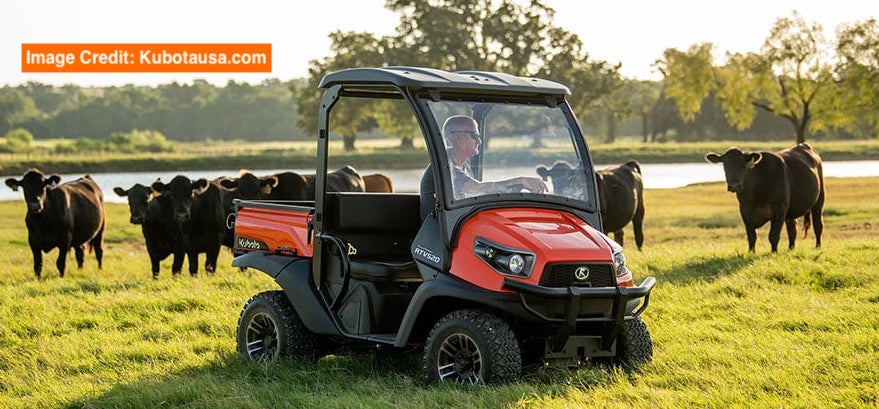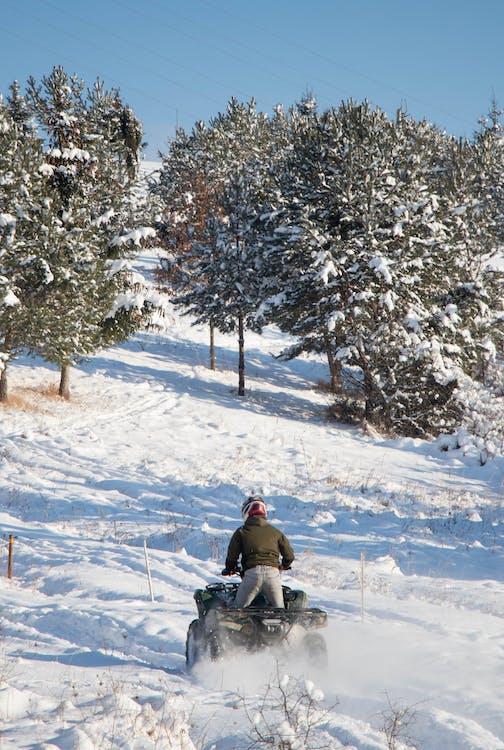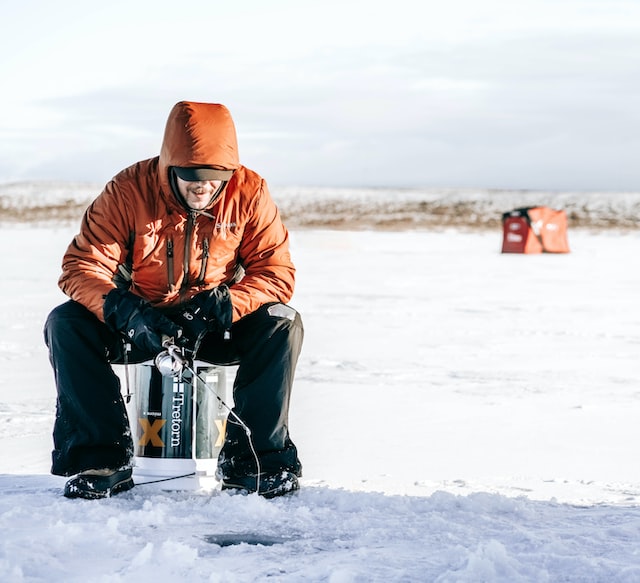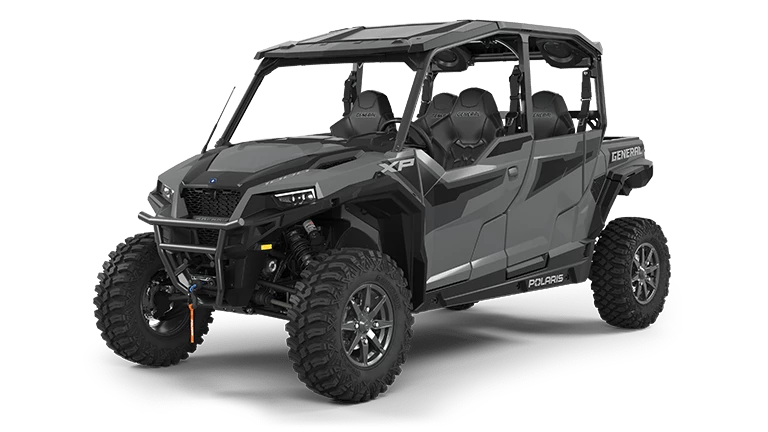As an Amazon Associate I may earn a commission from qualifying purchases at no additional cost to you.
Side-by-Side vs ATV. When it comes to off-road adventures, ATVs (All-Terrain Vehicles) and side-by-side UTVs (Utility Task Vehicles) have become increasingly popular choices for outdoor enthusiasts. While both can offer thrilling experiences, there are several advantages to choosing a side-by-side ATV over a traditional ATV.
One of the most apparent differences between the two types of vehicles is the seating arrangement. A traditional ATV usually has a seat for the operator and possibly a passenger seated behind the operator. In contrast, side-by-side UTVs provide seating for two or more riders, allowing an operator and passengers to enjoy the ride together comfortably. Moreover, UTVs offer added protection with surrounding bars in the passenger area, minimizing the risk of injury in the event of a rollover.
A side-by-side ATV is also better suited for heavy-duty work, possessing more power, higher payload, and increased towing capacity compared to their ATV counterparts. This makes them an ideal choice for those who plan on using their off-road vehicle for more demanding tasks.
Don’t just take our word for it. U.S. News provides several reasons to opt for a side-by-side ATV, highlighting its versatility and practicality for both work and leisure activities.
Greater Stability and Control
One of the key advantages of choosing a side-by-side ATV over a traditional ATV is the greater stability and control they offer. This is primarily due to their wider stance and lower center of gravity, which reduces the risk of rollovers and makes them more manageable on uneven terrain.
Side-by-side ATVs, also known as UTVs, generally have roll bars and doors, as well as windshields and roofs, which provide added security and protection for the driver and passengers. These features, combined with a more spacious seating arrangement, offer greater comfort for longer rides, making it easier to navigate challenging trails and terrain.
In addition to improved stability, side-by-side ATVs often come with better overall control, such as power steering and advanced suspension systems. These enhancements not only make the ride smoother but also provide the driver with more precise handling capabilities. These factors make side-by-side ATVs ideal for various off-road activities, including:
- Hunting
- Farming
- Ranching
- Recreational trails
Overall, the increased stability and control offered by side-by-side ATVs make them a safer and more versatile choice over traditional ATVs, especially for those who plan to use them for a variety of recreational and practical purposes.
Increased Passenger Capacity
One of the main advantages of choosing a side-by-side ATV (also known as a UTV or SxS) over a traditional ATV is the increased passenger capacity. While traditional ATVs are typically designed for a single rider or, at most, one additional passenger seated behind the operator, side-by-side ATVs offer seating arrangements similar to those of cars and trucks, allowing for more passengers to be accommodated in a single vehicle.
Side-by-side UTVs are available in various seating configurations, with some models allowing for two riders (an operator and a passenger) and others offering multiple seats for up to six riders, depending on the specific model and manufacturer. Some popular 4-seater or 6-seater options for families include the Can-Am Maverick Sport MAX DPS, as mentioned in the Can-Am Off-Road – BRP article.
The increased passenger capacity of side-by-side ATVs not only enhances the overall riding experience but also makes these vehicles more suitable for families and groups who wish to enjoy off-road adventures together. In addition, the bucket or bench seating, along with seatbelts and foot pedals, offers better comfort and safety compared to the straddle seating position found in traditional ATVs.
Enhanced Comfort and Convenience
One of the primary advantages of choosing a side-by-side ATV over a traditional ATV is the enhanced comfort and convenience they offer. Side-by-side ATVs, also known as UTVs, typically feature more comfortable seating arrangements for both the driver and passengers. Their seats often resemble those in a car, providing better back support and enabling users to sit more comfortably during long rides or challenging terrains.
Moreover, side-by-side ATVs have a spacious cabin area compared to traditional ATVs, which allows for more legroom and makes it easier for passengers to get on and off the vehicle. Many UTV models also come with a roof, providing protection from the sun and rain, and enhancing the overall riding experience.
Another advantage in terms of convenience is the availability of storage compartments in side-by-side ATVs. Riders can securely store their gear, tools, and personal belongings while exploring the great outdoors. Traditional ATVs, on the other hand, often lack sufficient space for larger items and may require additional equipment like racks or bags.
Side-by-side ATVs are also designed with better safety features, such as roll cages, seat belts, and side doors, offering extra protection for passengers. Some models even come with a windshield (or you can add one to most), providing additional shelter from the elements and debris during off-road adventures. These extra features can make the side-by-side a more appealing choice for families and groups, ensuring everyone can enjoy the ride comfortably and safely.
Increased Towing and Hauling Capabilities
One of the primary advantages of choosing a side-by-side ATV over a traditional ATV is the increased towing and hauling capabilities. Side-by-side ATVs, also known as UTVs, typically have more powerful engines and a larger payload capacity, making them ideal for various tasks that involve heavy lifting and towing.
UTVs can handle a higher payload capacity than ATVs, making it easy to transport equipment, supplies, and other materials on the work site or farm. This superior carrying capacity also allows users to customize their UTV with various accessories such as storage racks, cargo beds, and more, to better suit their specific needs (Polaris).
In addition to enhanced payload capacity, side-by-side ATVs also excel in towing capacity. Most UTVs have a built-in hitch receiver and can tow heavier trailers than traditional ATVs. This ability to tow heavier loads makes the side-by-side ATV an ideal choice for those who need to move large quantities of materials on a regular basis.
Despite their increased capabilities, side-by-side ATVs still offer similar handling and maneuverability as traditional ATVs. This combination of hauling capacity, towing strength, and ease of use makes side-by-side ATVs a more versatile choice for many users.
Versatility and Customization Options
Side-by-side ATVs, also known as UTVs or SxS, offer a wide range of versatility and customization options compared to traditional ATVs. This allows users to tailor their vehicles to their specific needs and preferences, making them suitable for various tasks and terrains.
One major difference between the two types of ATVs is seating capacity. Side-by-side ATVs typically have two or more seats, allowing for multiple passengers or additional cargo space, while traditional ATVs are primarily designed for single riders. This additional seating capacity makes side-by-side ATVs ideal for both recreational and utility purposes.
Customization options are also more abundant for side-by-side ATVs. Many models offer modular accessories, such as roof racks, winches, and cargo boxes that can easily be added or removed, depending on the user’s needs. Some side-by-sides even have options for enclosed cabins and heating systems, providing greater comfort and protection from the elements during colder months or harsh weather conditions.
Furthermore, side-by-side ATVs generally have more powerful engines and higher towing capabilities than traditional ATVs. These features allow side-by-sides to handle heavier loads, traverse rougher terrains, and carry essential tools and equipment for a variety of tasks, such as farming, hunting, or recreational off-roading.
Lastly, side-by-side ATVs offer additional safety features, such as roll cages and seat belts, which are not typically found on traditional ATVs. These enhancements help to reduce the risk of injury or accidents during off-road adventures.
Improved Safety Features
One of the primary advantages of choosing a side-by-side ATV (also known as a UTV) over a traditional ATV is the improved safety features that come standard on most UTVs.
While riding a traditional ATV can be an exhilarating experience, it also presents a higher risk of injury due to the lack of protective features found on UTVs.
A significant safety feature that side-by-side ATVs provide is the roll cage, which offers increased protection for riders in the event of a rollover accident. In contrast, traditional ATVs do not have a roll cage, making riders more vulnerable to injury in such scenarios.
Additionally, UTVs typically come equipped with seatbelts, which can help to prevent riders from being ejected from the vehicle during an accident. This is a crucial safety feature that is absent in most traditional ATVs.
Moreover, side-by-side ATVs generally have more stable and predictable handling than traditional ATVs due to their wider stance and seating configuration. This increased stability can help to reduce the likelihood of accidents caused by loss of control or sudden changes in terrain.
Finally, UTVs often provide better visibility for the driver, as their seated position and overall vehicle design offer a clearer line of sight to the surrounding terrain. This improved visibility can ultimately contribute to a safer riding experience compared to traditional ATVs.
If you want more information regarding Side-By-Side ATV’s check out our Side-by-Side Ultimate Guide.


